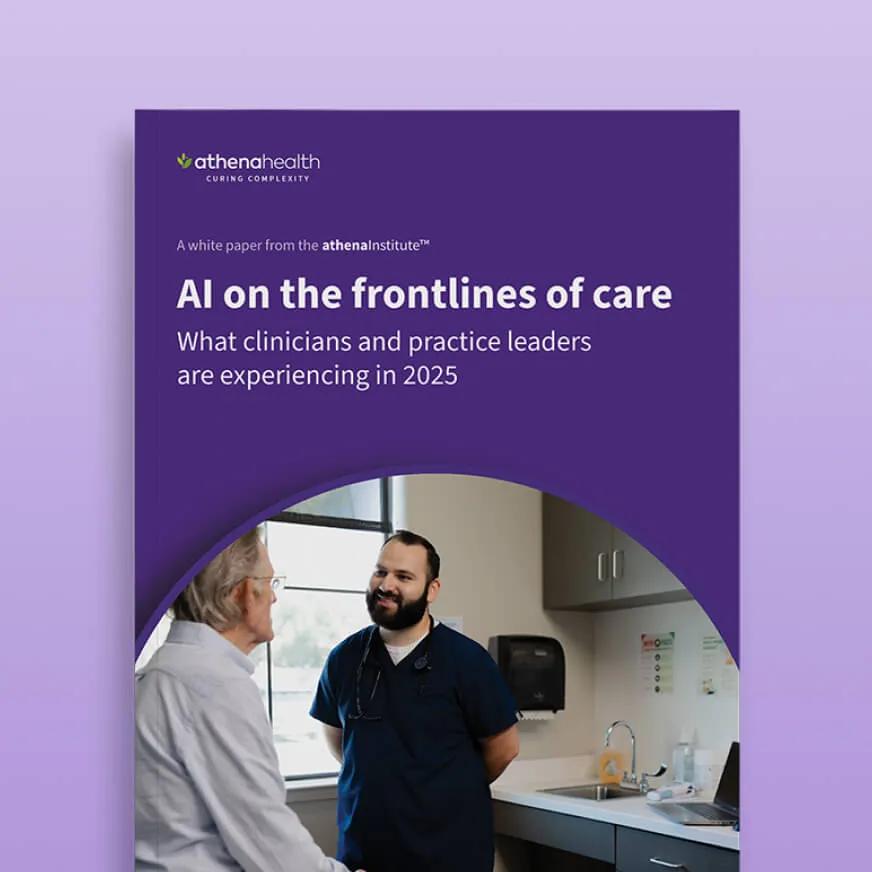Harnessing strong data foundations to help improve outcomes
Providing expanded access to data and ensuring timely sharing of that data offers benefits to healthcare providers and patients alike. But it only works when the data is usable and actionable. For health information technologies (HIT) striving to improve patient outcomes, a solution that can synthesize large datasets and enable AI-powered tools to function off that data is imperative.
But not all intelligence layers are created equal.
At athenahealth, our vision for an AI-native EHR includes a refined, Advanced Intelligence Layer that can help the healthcare ecosystem move closer to the vision of true interoperability. Find out what makes our Advanced Intelligence Layer different from the rest.
What is an intelligence layer?
A data intelligence layer is an integrated, foundational system that helps structure and contextualize large datasets and allows AI-powered tools to access the data for recommendations users can act on. In HIT, the intelligence layer serves as the basis for interplay between big data across a number of sources and the tools offered within an integrated system.
The intelligence layer doesn’t just engage with data. It embeds certain rules or standards and works to help ensure proper security and access controls. This can help build trust both in terms of data sharing and the utilization of context-rich data by AI-powered and other tools within integrated systems.
What separates the Advanced Intelligence Layer in athenaOne®?
As athenahealth Vice President of Product Development Chad Dodd said during a recent webinar, blending the existing intelligence layer within an integrated platform with a strong foundation of data distinguishes athenaOne from other solutions.
“It's how we combine this Advanced Intelligence Layer with this rich data network that really starts to create a unique and differentiated experience now,” Dodd said.
The difference between the Advanced Intelligence Layer in AI-native athenaOne and AI features in other solutions is largely defined by operational scale. By being on an integrated network, native AI can continuously learn and adapt from updates across the network.
Recently, athenahealth became the first IT company to implement TEFCA at scale for all eligible providers of the 160,000 providers in the network. As a cloud-based SaaS platform, athenaOne is capable of servicing real-time updates without the need for additional layers of integration, instead capitalizing on a large historical data backbone.
The native AI within the EHR also serves as a differentiator. AI agents constantly update and structure data as clinicians operate within the EHR – providing actionable insights that flow seamlessly and securely throughout the health data ecosystem. Additionally, an AI-native EHR like athenaOne will draw from an expansive toolset – including deterministic models, large language models (LLMs), rules engines, and clinical data services – to engage with the data and act on it in different ways depending on the desired clinical output, like documentation needs vs. aiding clinical judgment.
Ultimately, the goal is to provide a more efficient, connected, and patient-centered experience that can help enhance outcomes, strengthen financial resilience, and make care smarter, faster, and more compassionate.
“AI features in other solutions is largely defined” instead of “intelligence layers in other solution”.
How new AI tools capitalize on the Advanced Intelligence Layer
Dodd and other members of the product team discussed how athenahealth’s AI vision is more than the sum of its parts, with the advanced intelligence layer at the core for enablement and driving toward desired outcomes.
Within the EHR, AI-powered tools aim to give clinicians a dynamic assistant that can help reduce cognitive load and allow physicians to focus on medicine while fostering improved patient relationships. This includes new tools that provide personalized, context-aware recommendations with predictive analysis.
ChartSync document summaries
The ChartSync tool in athenaOne allows clinicians to view consolidated, deduplicated data from numerous external sources and add it to the patient chart. ChartSync document summaries can help provide even more clarity while reducing clutter.
Generative AI summarizes hospital documents available via the Patient Record Sharing (PRS) feature. Rather than sifting through potentially irrelevant documentation, clinicians can get concise briefings, then download and view their chosen documents based on the summaries. Research in the Beta testing phase of the tool showed a 95% accuracy rate for the AI-generated summaries.1
Care Events
To help with cumbersome hospital discharge documentation, the Care Events tool can help tie Admission Discharge Transfer (ADT) events to related documentation and data. It consolidates the data regarding a discrete care event and provides event-level summaries for clinicians to review and potentially act on.
Patient summaries
Clinicians on a tight schedule may not have time to click through patient charts as they bounce from encounter to encounter during the course of the day. Patient summaries can quickly obtain and synthesize the most relevant patient data to help enhance preparedness and contribute to better patient encounters.
Using generative AI, this tool can summarize relevant insights from past encounters. Perhaps more relevant in the context of the Advanced Intelligence Layer is how patient summaries can pull external data for new patients to help clinicians establish strong rapport ahead of the first encounter. The immediate availability of quick, usable data matters not only in terms of clinical preparedness, but also in building patient satisfaction.
Clinically Inferred Diagnosis
Native AI within athenaOne EHR will leverage comprehensive chart data across previous encounters, labs and imaging, medications, procedures, and past medical history and undergo predictive analysis. The AI can provide clinically inferred diagnoses to help clinicians make informed decisions.
But it’s not as simple as surfacing a possible diagnosis. The AI will provide clinicians with the full context behind the recommendation and link to clinical evidence directly in the chart, putting clinicians directly in the middle of the process.
Chart Assistant
Chart Assistant is a clinical AI aide, which we are calling Sage, meant to help clinicians navigate patient charts without leaving the charts themselves. Instead, clinicians can pull up Chart Assistant – which is embedded in the right-hand corner when they enter patient charts – and ask Sage to help pull data or analyze trends.
Clinicians can navigate through AI-generated patient summaries while accessing recent health changes up front. They can also ask Sage additional questions – there are over 300 unique prompts – and add notes or follow-ups within the chart during the course of the conversation.
An Advanced Intelligence Layer complemented by smart, adaptive tools
The athenaOne Advanced Intelligence Layer exemplifies how harnessing vast, interconnected data through industry-leading standards like TEFCA empowers healthcare providers with access to timely, comprehensive information. By embedding native AI capabilities directly within the EHR, athenaOne not only synthesizes this wealth of data but also simplifies and transforms it into actionable insights that can help reduce cognitive burden and inform clinical decision-making.
This intelligent fusion of rich data networks and sophisticated AI-powered tools offers clinicians a connected and compassionate care experience—one aimed at driving better health outcomes and establishing operational resilience. Explore how athenaOne’s Advanced Intelligence Layer can revolutionize your practice’s workflow and patient care by learning more about our AI-driven solutions today.
More AI in healthcare resources
Continue exploring
- Based on athenahealth 2025 internal data













